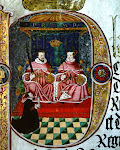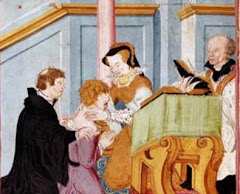 A while back I made a post on Mary’s connection to Beaulieu Palace, including a recent archaeological dig there that has unearthed a nursery that was probably made for Mary.
A while back I made a post on Mary’s connection to Beaulieu Palace, including a recent archaeological dig there that has unearthed a nursery that was probably made for Mary.This short post looks at evidence of another residence used by Mary – her apartments at Whitehall Palace. The extravagance of her apartments gives us some indication of the way in which Mary was treated and regarded by her father, Henry VIII, who constructed the rooms for her.

The images depicted here are from two paintings of Whitehall Palace. The image on the top comes from a painting of Whitehall made in c.1700 whilst the other is from The Lord Mayor’s Procession on the River Thames (artist unknown, mid-seventeenth century). The building focused upon is the lodgings of Mary which were situated by the riverside gallery and were completed in 1543, five years prior to the death of her father. Her Whitehall lodging consisted of a small courtyard house which the building accounts describe as ‘my lady maries newe lodging’.[1] It was built on the two southernmost bastions of the river wall which were used as bases for two-storey bay windows, with oriel windows set at first-floor level. The intervening wall space was also filled with windows to make the east wall of the lodgings more or less entirely glass on the first floor.
 The splendour of Mary’s apartments indicates the favour she enjoyed from her royal father. It was during this year that Mary was re-included in Henry’s succession via a parliamentary statue, despite her illegitimacy. The lodgings may also be a symbol of the steady harmonious relationship between Henry and Mary, which had initially been wrecked by Henry’s repudiation of Katherine of Aragon, his break from Rome, Mary’s own downgrade in status, and Mary’s refusal to recognise the legality of her father’s actions. In June 1536 Henry managed to break Mary’s resolve, and after swearing to recognise Henry’s ecclesiastical status, the invalidity of her parent’s marriage and her own illegitimate status, Mary set to present herself as the king’s obedient daughter. Furthermore it seems that Henry enjoyed Mary’s company and that Mary had established a place for herself at court. Interestingly 1543 was the year Henry married Katherine Parr who was a member of Mary’s household. It is possible that Henry began to take notice of Katherine during visits with his daughter. Such visits were frequent; by February 1543 one contemporary noted that the king ‘was calling at [the princess’] apartments two or three times a day’ [2]. It is therefore possible that these lodgings provided a setting for Henry’s pursuit of his last wife.
The splendour of Mary’s apartments indicates the favour she enjoyed from her royal father. It was during this year that Mary was re-included in Henry’s succession via a parliamentary statue, despite her illegitimacy. The lodgings may also be a symbol of the steady harmonious relationship between Henry and Mary, which had initially been wrecked by Henry’s repudiation of Katherine of Aragon, his break from Rome, Mary’s own downgrade in status, and Mary’s refusal to recognise the legality of her father’s actions. In June 1536 Henry managed to break Mary’s resolve, and after swearing to recognise Henry’s ecclesiastical status, the invalidity of her parent’s marriage and her own illegitimate status, Mary set to present herself as the king’s obedient daughter. Furthermore it seems that Henry enjoyed Mary’s company and that Mary had established a place for herself at court. Interestingly 1543 was the year Henry married Katherine Parr who was a member of Mary’s household. It is possible that Henry began to take notice of Katherine during visits with his daughter. Such visits were frequent; by February 1543 one contemporary noted that the king ‘was calling at [the princess’] apartments two or three times a day’ [2]. It is therefore possible that these lodgings provided a setting for Henry’s pursuit of his last wife.
On my YouTube channel I have posted a video on Whitehall which features Simon Thurley. It gives some idea of what the palace was like during Henry VIII’s reign:
http://www.youtube.com/watch?v=5NDbEBIGAUU
~~~~~~~~~~~~~~~~~~
[1] Source from Simon Thurley, The Royal Palaces of Tudor England: Architecture and Court Life, 1460-1547 (New Haven and London, 1993), p. 79.
[2] Susan James, Catherine Parr: Henry VIII’s Last Love (Gloucestershire, 2009), p. 77.




No comments:
Post a Comment